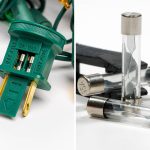The easiest way to make your non-blinking Christmas lights blink is to add a blinker bulb (also known as a flasher bulb) to the light string. But if you want even more control over how the lights flicker, you will have to get a set of chasing lights.
Make Your Christmas Tree Lights Blink Using a Blinker Bulb
Before you start the process, plug the lights in and test to see that all the lights are working. If they are working, you may proceed.
Before you start converting your non-blinking lights to blinking lights, ensure you disconnect/unplug the entire string from any power source. If you leave the lights plugged while working on them, you are at risk of electrocution.
Once you have confirmed that the lights are unplugged, follow these steps:
Step 1: Straighten the Entire String
While this is not a technical step in the process, it can make everything easier for you. For one, a straightened/untangled light string is easier to navigate.
Step 2: Unplug One of the Bulbs on the Light String
While you can unplug any of the bulbs on the light string, the popular recommendation states that you remove one of the first few bulbs on the string. In other words, unplug one of the bulbs closest to the Christmas lights’ plug.
If the bulbs are screw-in bulbs, simply unplug the bulb by unscrewing it. But if the bulbs are snap-in bulbs, do the following:
- To pull the bulb out without damaging it, hold the bulb receptacle with your forefinger and thumb.
- Next, using the fingers in your other hand, put your fingernails under the ring-like plastic base of the bulb. Then, gently pull apart.
If you do not unplug the bulb as described above, there’s a good chance you will pull the glass out, leaving the base stuck inside the receptacle. Unfortunately, the base can be pretty hard to remove when this happens.
Step 3: Put a Blinking Bulb in the String
This step is the defining step. At this point, all you have to do is put a blinking bulb in place of the unplugged non-blinking bulb in step 2.
Step 4: Test the Christmas Lights
After inserting the blinking bulb, you are pretty much done with the process of making your Christmas lights twinkle. Now, all you have to do is plug the lights in and see if they twinkle.
It may take a few seconds, but when you plug the lights in, they should start blinking. But then, if you notice that some lights twinkle while others don’t, the entire string may have more than one circuit.
Typically, string lights with 50 bulbs will have one circuit, so all the bulbs will twinkle when you test the lights. Conversely, string lights with 100 bulbs or more use more than one circuit. So, the bulbs not connected to the same circuit as the blinking bulb will not flash.
If some bulbs do not twinkle when you are testing the lights, do the following:
- Unplug a bulb from the non-blinking side of the string.
- Replace the unplugged bulb with a second blinking bulb.
- Test the lights again to confirm that all the bulbs are now twinkling.
Once all the bulbs blink, you are done making your Christmas string lights twinkle.
Note: Adding a blinking bulb to a string of non-blinking bulbs may halve the operating life of the non-blinking bulbs.
Where to Get Blinking Bulbs
Some mini lights come with an accessory pack that contains blinking bulbs and some other items like fuses. But if your light string does not come with a blinking bulb in an accessory pack, you can buy one separately.
How Flasher Bulbs Make Christmas Lights Twinkle
Flasher bulbs (blinking bulbs or twinkling bulbs) twinkle because they expand and contract with heat gain and heat loss, respectively.
Blinking bulbs have a bi-metallic strip, which controls the flow of current to their filaments. When the bulbs light up, their filaments get hot, and as the filaments get hot, the bi-metallic strip gets hot.
When hot enough, the bi-metallic strip expands and bends, disconnecting the flow of current to the filament temporarily. This causes the bulb to go off.
When the bulb goes off, the filament and bi-metallic strip start cooling. As they cool, the bi-metallic strip contracts, straightens, and allows current to reach the filament again. This causes the bulb to come back on.
The cycles of heating & cooling, bending & straightening, expanding & contracting cause blinking bulbs to go on and off periodically. This is what we perceive as blinking/twinkling.
So, how do flasher bulbs make Christmas lights twinkle? Well, when all the lights in a string are connected to the same circuit, if one of the bulbs goes off, every other bulb will go off. So, whenever the flasher bulb in a light string goes off, every other bulb will go off with it. Then when the flasher bulb comes back on, every other bulb will come back on.
When you make Christmas string lights twinkle using flasher bulbs, the twinkling is not quite random. The twinkling is fixed as it depends on the heating and cooling rate of the bi-metallic strip in the flasher bulb. But if you want a random twinkle, you should get chasing lights.
Chasing lights have multiple circuits and come with a 16-function Christmas tree lights controller. These features make it possible to vary the lights in many ways.
What Happens When One of the Bulbs in My Christmas String Lights Blows?
The answer to this question depends on the type of circuit your lights use. If your string lights use a series circuit, when one bulb blows, every other bulb will go off until you replace the blown bulb.
Conversely, if your string lights use a parallel circuit when one bulb blows, the other bulbs are unaffected.
These days, some string lights use multiple circuits where bulbs in subsections of the string are connected in series. Then each subsection is connected to the other in parallel. So, when one bulb in a subsection of the string blows, only that subsection stops working. Every other subsection keeps working.
In LED lights, when a bulb blows, it still allows the flow of current. So, other bulbs connected in series with the blown bulb will still come on.










